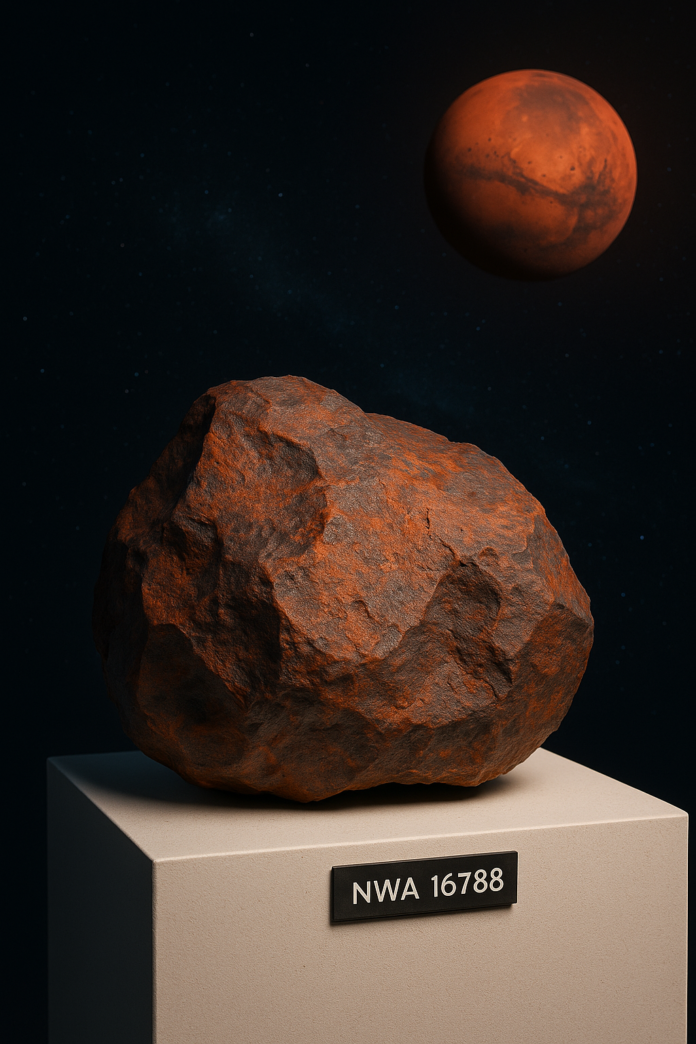
A rare Martian meteorite, the largest of its kind ever discovered on Earth, sold for $5.3 million at Sotheby’s New York auction on July 16, 2025. Weighing just over 54 pounds (24.67 kg), the specimen known as NWA 16788 drew international attention for both its scientific value and its journey from the red planet to Earth. Despite the record-breaking sale, the spotlight shifted when a juvenile Ceratosaurus skeleton fetched more than $30 million during the same event.
NWA 16788 was found in November 2023 by a meteorite hunter in the Agadez region of Niger. The rock’s size—nearly 15 inches long and 70% larger than the next-largest Martian specimen found on Earth—made it a centerpiece of Sotheby’s “Geek Week” auction. Scientists believe the meteorite was launched from Mars by an asteroid strike before embarking on a 140-million-mile journey through space. Eventually, it landed on Earth with minimal weathering, suggesting it arrived relatively recently.
The meteorite’s reddish hue and composition were confirmed by labs and matched against known Martian materials, including samples examined during NASA’s Viking mission. Experts classified the specimen as an olivine-microgabbroic shergottite, a volcanic rock formed from slowly cooled magma. Its partially glassy surface is believed to have formed as it passed through Earth’s atmosphere, subjected to extreme temperatures.
Bidding for NWA 16788 started with offers just under $2 million and rose gradually to a final hammer price of $4.3 million. With fees and other costs added, the total climbed to $5.3 million, making it the highest-priced meteorite ever sold at auction. Sotheby’s did not disclose the identity of the buyer.
Although the Martian meteorite made headlines for its price and rarity, it was the juvenile Ceratosaurus skeleton that created a buzz during the live auction. One of only four known skeletons of its kind—and the only juvenile—this late Jurassic fossil ignited a six-minute bidding contest involving six participants. The skeleton eventually sold for $30.5 million, becoming the third-highest dinosaur auction sale to date. The winning bidder, also unnamed, plans to loan it to a public institution.
The dinosaur was discovered in 1996 at Bone Cabin Quarry near Laramie, Wyoming, and later assembled with over 130 fossilized bones and additional sculpted material. Standing over 6 feet tall and nearly 11 feet long, the juvenile specimen offers insights into a species that lived roughly 150 million years ago.
While the Martian meteorite may not have commanded the highest bid of the night, its scientific and symbolic value remains immense. Out of over 77,000 officially recognized meteorites on Earth, only 400 are believed to be from Mars. NWA 16788 alone accounts for approximately 6.5% of all Martian material ever recovered.
In a world where celestial and prehistoric artifacts continue to captivate collectors and scientists alike, both items from Sotheby’s auction reflect humanity’s enduring fascination with the distant past—whether from deep space or ancient Earth.
This image is the property of The New Dispatch LLC and is not licenseable for external use without explicit written permission.